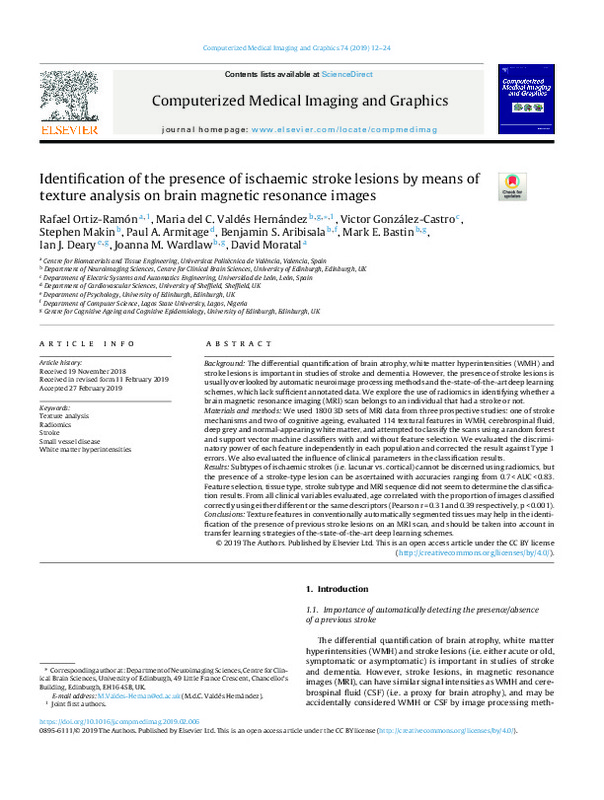|
Resumen:
|
[EN] Background: The differential quantification of brain atrophy, white matter hyperintensities (WMH) and stroke lesions is important in studies of stroke and dementia. However, the presence of stroke lesions is usually ...[+]
[EN] Background: The differential quantification of brain atrophy, white matter hyperintensities (WMH) and stroke lesions is important in studies of stroke and dementia. However, the presence of stroke lesions is usually overlooked by automatic neuroimage processing methods and the-state-of-the-art deep learning schemes, which lack sufficient annotated data. We explore the use of radiomics in identifying whether a brain magnetic resonance imaging (MRI) scan belongs to an individual that had a stroke or not.
Materials and methods: We used 1800 3D sets of MRI data from three prospective studies: one of stroke mechanisms and two of cognitive ageing, evaluated 114 textural features in WMH, cerebrospinal fluid, deep grey and normal-appearing white matter, and attempted to classify the scans using a random forest and support vector machine classifiers with and without feature selection. We evaluated the discriminatory power of each feature independently in each population and corrected the result against Type 1 errors. We also evaluated the influence of clinical parameters in the classification results.
Results: Subtypes of ischaemic strokes (i.e. lacunar vs. cortical) cannot be discerned using radiomics, but the presence of a stroke-type lesion can be ascertained with accuracies ranging from 0.7 < AUC < 0.83. Feature selection, tissue type, stroke subtype and MRI sequence did not seem to determine the classification results. From all clinical variables evaluated, age correlated with the proportion of images classified correctly using either different or the same descriptors (Pearson r = 0.31 and 0.39 respectively, p < 0.001).
Conclusions: Texture features in conventionally automatically segmented tissues may help in the identification of the presence of previous stroke lesions on an MRI scan, and should be taken into account in transfer learning strategies of the-state-of-the-art deep learning schemes.
[-]
|
|
Agradecimientos:
|
This work was funded by the Row Fogo Charitable Trust (MVH, VGC) grant no. BRO-D.FID3668413, and the Wellcome Trust (patient recruitment, scanning, primary study Ref No. 088134/Z/09). The study was conducted independently ...[+]
This work was funded by the Row Fogo Charitable Trust (MVH, VGC) grant no. BRO-D.FID3668413, and the Wellcome Trust (patient recruitment, scanning, primary study Ref No. 088134/Z/09). The study was conducted independently of the funders who do not hold the data and did not participate in the study design or analyses.
The Lothian Birth Cohort 1936 is funded by Age UK (Disconnected Mind grant) and the Medical Research Council (MRC; MR/M01311/1, G1001245, 82800), and the latter supported BSA. IJD was supported by the Centre for Cognitive Ageing and Cognitive Epidemiology, which is funded by the MRC and the Biotechnology and Biological Sciences Research Council (MR/K026992/1).
David Moratal acknowledges financial support from the Spanish Ministerio de Economia y Competitividad (MINECO) and FEDER funds under Grant BFU2015-64380-C2-2-R, and from the Conselleria d'Educacio, Investigacio, Cultura i Esport, Generalitat Valenciana (grants AEST/2017/013 and AEST/2018/021).
Rafael Ortiz-Ramon was supported by grant ACIF/2015/078 and grant BEFPI/2017/004 from the Conselleria d'Educacio, Investigacio, Cultura i Esport of the Valencian Community (Spain).
We thank participants in the studies that provided data for this
study, the radiographers and staff at the Brain Research Imaging
Centre Edinburgh (http://www.bric.ed.ac.uk/), a SINAPSE (Scottish Imaging Network A Platform for Scientific Excellence, www.
sinapse.ac.uk/) collaboration centre. We especially thank the following members of the research teams, who contributed to the
recruitment, data collection or image processing in the primary
studies, but did not participate in the analysis or writing of this
report: Dr. Susana Munoz Maniega, Dr. Natalie Royle, Mrs. Eleni
Sakka, Miss. Catherine Murray, Miss Kirsten Shuler.
[-]
|









